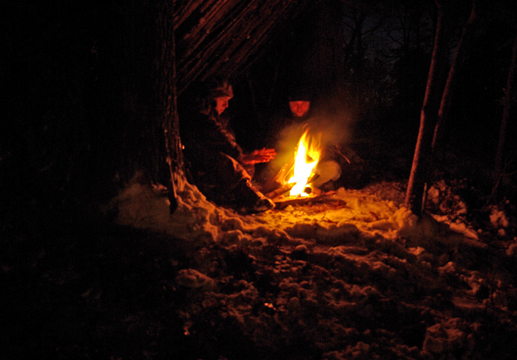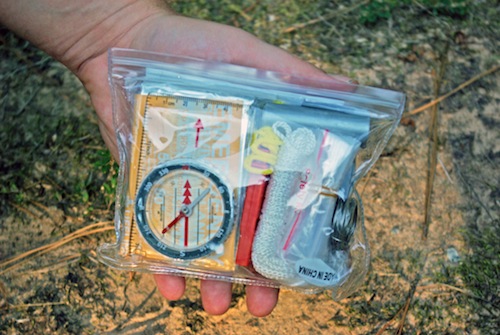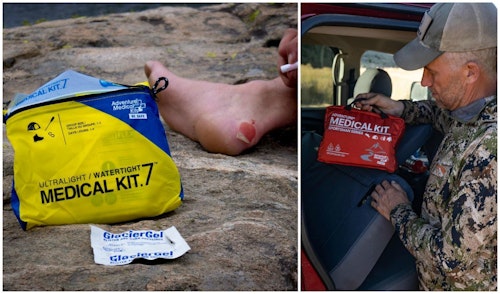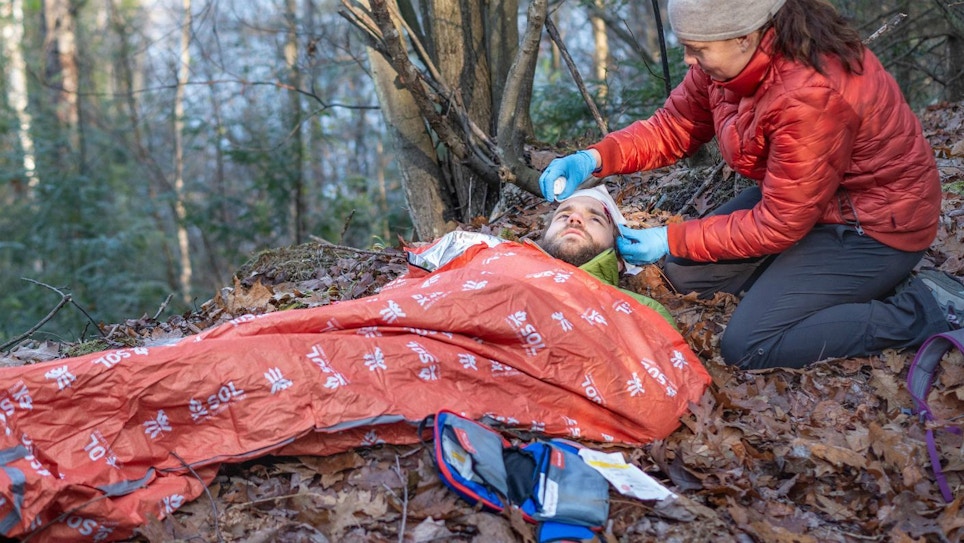On February 11, 2011, with eight inches of snow on the ground, Zach Sutton and Shaun Kizer of Alexander, Ark., camped in a survival shelter they built on a mountainside that afternoon. These two young outdoorsmen, both ardent hunters, did this to help hone their wilderness survival skills.
Long pine saplings were used to create a lean-to framework for their emergency bivouac shelter, which was then covered with green boughs to make it water resistant.
“Emergencies happen when you least expect them,” said Shaun as they thatched their shelter. “It’s important to know how to take care of yourself and stay safe and warm if you must spend a night outdoors alone without proper equipment.”
“We always carry emergency gear like a butane lighter for fire-starting and a compass to keep us from getting lost,” Zach said. “But preparing yourself with the knowledge needed to build a shelter, make a fire or handle an emergency gives you confidence you can survive regardless of the situation.”
That night, with the temperature in the teens, Shaun and Zach sat warm inside their makeshift lean-to in front of a blazing fire. Supper was a squirrel Zach killed, cooked on a stick.

Unlike Zach and Shaun, many people who consider themselves outdoorsmen have little knowledge of basic woodsmanship skills that can make life outdoors safer and more enjoyable. Many have no idea how to gather and cook wild foods without modern accoutrements, how to improvise or repair tools in the backcountry, or how to find their way back to camp without a GPS or map. Starting a fire with a single match and navigating by the stars are lost arts. If forced by calamity into a survival situation, many so-called “outdoor types” would find it difficult to stay warm, well-fed and healthy; some might perish.
“A pleasant hike or a leisurely afternoon of hunting can turn into an emergency situation in a matter of minutes,” says Alabama native J. Wayne Fears, author of The Complete Book of Outdoor Survival. “And that can happen to anyone, even in familiar terrain. An accidental fall, a capsized canoe, a sudden violent storm or even losing your bearings can leave you stuck miles from help or shelter. Naturally, these situations don’t happen often. But knowing how to take care of yourself until help arrives or until you can get back to civilization is every bit as important as your knowledge of hunting, marksmanship or hiking. And sometimes your life may depend on it.”

Second, plan your trip carefully. Be familiar with the terrain you’ll encounter and typical weather conditions. Carry a survival kit, a first-aid kit and other essential. Take extra food, water and clothing. Prepare for the physical rigors you may encounter.
“The challenge to a lost, injured or stranded victim is usually far more mental than physical,” says Fears. “For example, many people worry they must immediately begin finding sources of food. But since nearly all victims are found within a few days of their disappearance, there’s usually little need to worry about starving to death. Little need, that is, provided you told a reliable person where you were headed and when you planned to return, so searchers would know where to begin looking.
“Your best survival kit is your mind,” the survival expert notes. “Feed it survival knowledge, and it will be ready when that knowledge is needed.”
One skill you can easily learn now is how to improvise a survival shelter. If you find yourself in a survival situation, and weather is likely to be bad, shelter construction is very important.
Begin by selecting the proper site for your shelter — a level spot where you can easily be seen by searchers, but away from thick brush, standing dead timber and low areas that could flood.
Among the easiest-to-build shelters in many areas are bough structures that will reflect a fire’s warmth, break the wind and provide cover from rain or snow. These can be erected without tools in an hour in an area with downed timber — less if you find a makeshift ridge pole such as a leaning tree to support the boughs.
Start by finding a ridge pole (a horizontal cross piece) at least 6 to 10 feet long. Wedge it into the lower forks of two closely growing trees (one end can rest on the ground if necessary), or support the ends of the ridge pole with tripods of upright poles lashed together near the top.
Next, find branches or poles you can lean upright against the ridge pole to make a frame. To strengthen this, interlace limber boughs through the poles at right angles.
The best cover for your shelter is a tarp, piece of plastic sheeting or a space blanket. But if necessary, you can thatch the lean-to with slabs of bark and/or leafy or pine-needle branches, weaving them into the framework. The shelter will be more water repellent if you weave in large leaves or pieces of bark in patterns like those for roof shingles. Chink with sod, moss or snow to further insulate.
“We’ve learned a lot by watching television shows like Survivorman and Man vs. Wild,” said Shaun Kizer. “And there are lots of good books that teach wilderness survival skills as well.”
“It’s important, though, to actually get outside and try the things you read about or see on TV so you know you can actually do them.” Zach Sutton added. “That’s why we decided to construct our own shelter and spend the night in it. Some things are harder to do than you might think. Practice helps.”
Seeing these young men warm in their survival shelter on a snowy night, one imagines they won’t find it difficult to live, and live well, no matter what nature throws at them.







